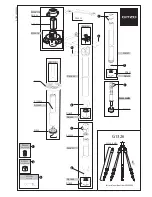
BT32i Differential Voltage sensor User’s Guide
| 3
Practical information
CAUTION:
NEVER
use high voltages or household AC.
•
The Voltage sensor is used to measure the potential difference between the ends
of an electrical component and is therefore connected across (i.e. in parallel) the
component.
•
Make sure you observe the correct polarity i.e. connect the black lead from the
Voltage Sensor to the negative terminal of the cells, otherwise the sensor will give
readings with the wrong sign.
•
The Voltage Sensor(s) can be used in conjunction with a Current sensor(s)
anywhere in a circuit.
Suggested experiments
The Differential Voltage sensor is specifically designed for accurate measurements of
low voltages. It can be used in various experiments such as:
•
Charging and discharging capacitors,
•
Characteristics of a light bulb and a diode,
•
Measurements of internal resonance and EMF,
•
Measurements in series and parallel electrical circuits,
•
Together with a Current Sensor it can be used to explore the relationship
between the current and the voltage in electrical circuits -‐ the Ohm’s Law.
Figure 1. Measuring a battery voltage.
Figure 2. Measuring the voltage during
discharging of a capacitor.






















